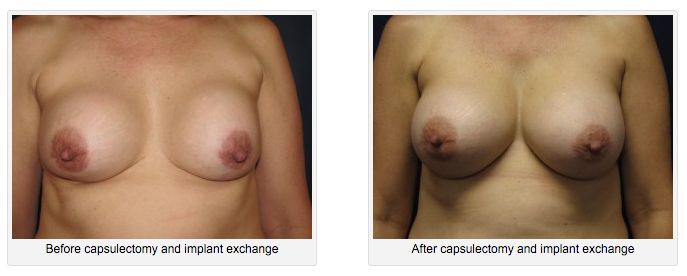Home|Blog | How to Reduce Your Risk of Capsular Contracture
How to Reduce Your Risk of Capsular Contracture
Like any other surgical procedure, breast augmentation is not without risks. One complication that is associated with breast augmentation is capsular contracture. This can occur at any point in time following the procedure – from within a few months to even many years later. While Dr. Turkeltaub can surgically treat capsular contracture if it occurs, there are some ways that you may be able to reduce your risk of developing it.
What Causes Capsular Contracture?
After surgical insertion of a breast implant, the body normally forms a tissue “capsule” around the implant as part of the healing process. Capsular contracture occurs when this tissue capsule begins to shrink in encompassed volume, thicken and tighten around the implant causing the breast to feel hard. This can lead to visual breast deformities and pain.
Capsular contracture can often be improved or amply treated with non-surgical regimens in many women, particularly if they seek treatment very early in the process. Breast revision surgery involving either release or excision of the abnormal capsule is a very predictably effective treatment.
Reducing Your Risk of Capsular Contracture
The following suggestions may help reduce your risk of developing capsular contracture after breast augmentation:
Choose Submuscular Placement
Research has proven that submuscular placement (placing breast implants beneath the chest muscle) rather than in front of it (submammary/subglandular) reduces the risk of developing capsular contracture.
When Implants Are Being Placed Above the Muscle, Consider Using Textured Ones
With subglandular (over the muscle) placement, textured implants have been proven to have a slightly lower risk of capsular contracture than smooth implants. However, this has to be weighed against the risk of rippling of the skin and greater palpability of the implants.
There is no significant difference in capsular contracture rates for different implant types with submuscular (under the muscle) placement.
Avoid the Periareolar Incision Technique
Though this approach may be preferred by some, the risk of developing capsular contracture is higher in comparison to other insertion approaches. Because this technique inserts the implant through the milk ducts, it increases the risk of transferring bacteria to the breast pocket. Increased amounts of bacteria here can elevate the risk of capsular contracture.
Avoid Smoking
Smoking causes blood vessels to constrict, which impedes the body’s natural healing response. It may also increase your risk of capsular contracture, which is another reason it is important to avoid smoking for at least six weeks before surgery and for six weeks after surgery.
Avoid Blood Thinners
Accumulation of blood around the implant following surgery does elevate your risk for developing capsular contracture. Blood thinners such as ibuprofen, aspirin, supplements like vitamin E or fish oil should be avoided starting from around two weeks before to two weeks after breast augmentation surgery.
Implant Compression Exercises
Though there is no scientific evidence that this can prevent the occurrence of capsular contracture, Dr. Turkeltaub recommends starting compression exercises involving moving the implants around in the pocket early in the postoperative period. This doesn’t apply to textured surfaced anatomic shaped implants.
Follow Doctor Recommendations
Dr. Turkeltaub will provide you with explicit instructions to follow during your postoperative course. By adhering closely to these, you may be able to reduce your risk of developing capsular contracture.
To find out more about how to reduce your risk of capsular contracture or to schedule your consultation for breast augmentation, contact board-certified plastic surgeon Dr. Steven H. Turkeltaub. Call us at (480) 451-3000 or fill out our online contact form to book your appointment today.
